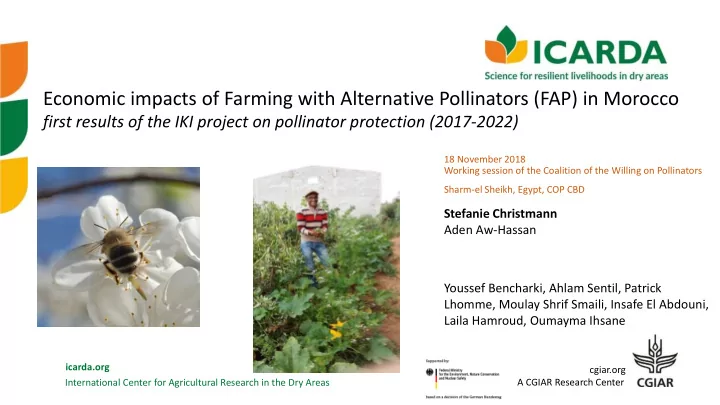

Economic impacts of Farming with Alternative Pollinators (FAP) in Morocco first results of the IKI project on pollinator protection (2017-2022) 18 November 2018 Working session of the Coalition of the Willing on Pollinators Sharm-el Sheikh, Egypt, COP CBD Stefanie Christmann Aden Aw-Hassan Youssef Bencharki, Ahlam Sentil, Patrick Lhomme, Moulay Shrif Smaili, Insafe El Abdouni, Laila Hamroud, Oumayma Ihsane icarda.org cgiar.org International Center for Agricultural Research in the Dry Areas A CGIAR Research Center
Farm rming wit ith Alt lternative Poll llinators (F (FAP) ba base sed on on TEEB Christmann, S. 2018. Under which conditions would a wide support be likely for a Multilateral Environmental Agreement for pollinator protection? Environmental Science and Policy, https://doi.org/10.1016/j.envsci.2018.10.004 Christmann, S. Aw-Hassan, A., Rajabov, T., Khamraev, A.S., Tsivelikas, A. 2017. Farming with Alternative Pollinators increases yields and incomes of cucumber and sour cherry. Agronomy for Sustainable Development. DOI: 10.1007/s13593-017-0433-y Christmann, S., Aw-Hassan A.A., 2012. Farming with Alternative Pollinators (FAP) – an overlooked win-win- strategy for climate change adaptation. In: Agriculture, Ecosystems and Environment 161, 161-164 http://repo.mel.cgiar.org/handle/20.500.11766/8332 And various brochures for farmers icarda.org 2
Photo: Nicolas Vereecken Current approaches to protect wild pollinators are not scalable as Low and Middle Income Countries cannot afford - rewards for wildflower strips - sponsored events to provide information and convince stakeholders
Sh Shift ift from poll llin inator-frie iendly ly agri ricult lture to to farm rmer-fr frie iendly ly pollin llinator protectio ion FAP field - Main crop in 75% of the field - Habitat enhancement in 25% of the field * Three-season-forage buffets by MARKETABLE plants * Shelter (wind, shadow) by crops * Nesting support out of local materials * Water Control field Main crop in 100 % of the field
5 We assess the impact of habitat enhancement: - Insect diversity and abundance (pollinators, native enemies, pests) - Total net income per surface Farmers - decide on inputs (→ low inputs) - contribute to selection of habitat enhancement plants
Zucchini Zucchini Zucchini 2018 Settat pumpkin field sketch Sunflower Coriander - low investment for farmers Sunflower Coriander - high pay-off already in the first year Pumpkin Sunflower Coriander - easy to communicate by ICT Okra Cumin
Main FAP impacts: control FAP Higher pollinator and predator diversity and abundance → More flowers develop a fruit → Better quality → Less pests/chemicals needed The 25% zone of FAP fields provides substantial net income as well. →Net income per surface much higher, but depending on crop and ecosystem
8 Based on FAP trials 2013-2014 in Uzbekistan and 2015-2018 in Morocco: FAP is scalable across continents Net income increases FAP versus control fields are very high (trials in 4 ecological zones of Morocco with different crops) - Usually more than 50% higher - Often more than 100% higher - In trials surrounded by large monocultures of cereals, crops with „essential“ (Klein et al. 2007) pollinator dependency in Morocco income increase can reach up to some hundert percent income increase (trials 2018, replication planned for 2019) → Farmers understand the value of pollinators and native enemies
9 The increase is different due to - The conditions in the respective ecological zone for pollinators - The pollinator dependency of the respective crop - The abundance of honeybees during flowering The higher net income is based on - Higher productivity of the main crop in FAP fields - In some cases: better quality or size of the main crop - The net income from the 25% zone in FAP often exceeds the income from the 25% zone in control, in particular, if the main crop is heavily affected by pests
Full ll FAP-projects lik like this is IK IKI-proje ject have 4 4 steps build a scalable model for pollinator protection in Morocco - Demonstrate the higher income by FAP by on-farm-trials comparing FAP and control fields to trigger intrinsic motivation of farmers for pollinator protection in fields and orchards - Planting pollinator corridors (wild fruit tree species, berries, medicinal plants) between enhanced agricultural and natural sites in cooperation with farming communities having already positively experienced step 1 - Nation wide assessments of the value of pollination services and of regions with pollinator lack to stimulate cooperation of political stakeholders across sectors - Mainstreaming pollinator protection by national governments across sectors
We We can do it! it! MEA FAO Coalition of the Willing next COPs CBD on Pollinators COP since CBD 2016 IKI project 2017-22 24 member states → scalable self- = ca. 12.5% of all sustaining pollinator countries worldwide protection High awareness of pollinator decline globally Hallmann et al. 2017 IPBES report spring 2016 icarda.org 11
Poll llinator protection should be be feasible in in all ll countries Let‘s do it! s.christmann@cgiar.org icarda.org 12
Recommend
More recommend